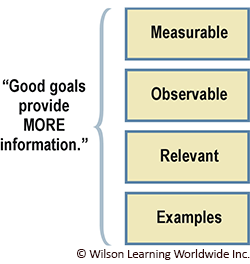Setting Goals for Success
Setting goals is the foundation of developing employees for Performance with Fulfillment—that productive, satisfying condition where people get a lot done and are fulfilled. New or inexperienced managers are often unaware or unable to effectively handle the challenges that can arise when establishing goals. As a result, their employees are unclear about direction and expectations, resulting in reduced commitment, low morale, and achievement well below what is possible.
In Leading for Performance: Setting Goals for Success (LFP-SGFS), participants will examine the characteristics of effective goals, the need for goals to address both performance and fulfillment, best practices for linking goals to strategy execution, and proven goal-setting processes.
Program Outcomes
Clear performance expectations and goals align individuals, departments, and the organization. Leading for Performance: Setting Goals for Success enables first-line and mid-level managers to set goals for themselves and with their employees. This will ultimately contribute to long-term individual satisfaction and improved work group and organizational performance.
Approach
Leading for Performance: Setting Goals for Success is a half day instructor-led module that can be facilitated by Wilson Learning or by a leader-trained in-house professional.
This enables:
- Face-to-face interaction among the participants and with the facilitator
- True-to-life skills practice with immediate in-person feedback
- The opportunity for real-time commitment to action
Enabling Improved Performance
Leading for Performance: Setting Goals for Success features the Setting Goals Planner and Job Aid Card so participants can fine-tune and apply their newly acquired skills and behaviors on the job. Involving participants' managers and training them to coach is important for successful implementation.
Measurement and Evaluation
Organizations that implement Leading for Performance: Setting Goals for Success have access to a broad range of tools to measure initial behavioral changes and business results. One approach may be surveying participants' direct reports to quantify the change and the results.
To learn more about measuring the impact of learning, visit Measurement and Evaluation Services.



 Please complete this form to download the factsheet for Setting Goals for Success.
Please complete this form to download the factsheet for Setting Goals for Success.



